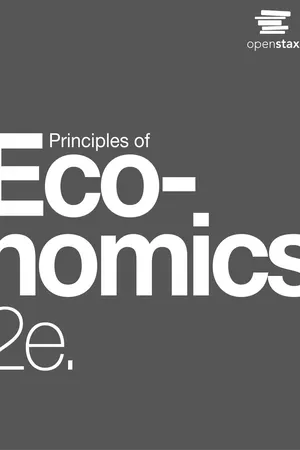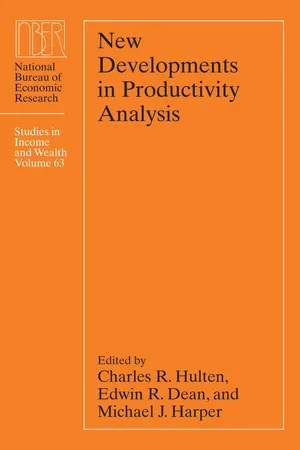Economics
Growth in Productivity
Growth in productivity refers to the increase in the efficiency of producing goods and services. It is often measured by the amount of output produced per unit of input, such as labor or capital. Higher productivity leads to economic growth as it allows for more output to be produced with the same amount of resources, leading to increased standards of living and higher incomes.
Written by Perlego with AI-assistance
Related key terms
1 of 5
11 Key excerpts on "Growth in Productivity"
- No longer available |Learn more
- (Author)
- 2014(Publication Date)
- Orange Apple(Publisher)
____________________ WORLD TECHNOLOGIES ____________________ Chapter- 6 Productivity Productivity is a measure of output from a production process, per unit of input. For example, labor productivity is typically measured as a ratio of output per labor-hour, an input. Productivity may be conceived of as a metric of the technical or engineering efficiency of production. As such, the emphasis is on quantitative metrics of input, and sometimes output. Productivity is distinct from metrics of allocative efficiency, which take into account both the monetary value (price) of what is produced and the cost of inputs used, and also distinct from metrics of profitability, which address the difference between the revenues obtained from output and the expense associated with consumption of inputs. Comparison of average total productivity levels between the OECD member states. Productivity is measured as GDP per hour worked. Blue bars = higher than OECD-average productivity. Yellow bars = lower than average. ____________________ WORLD TECHNOLOGIES ____________________ Economic growth and productivity Components of economic growth (Saari 2006) Production is a process of combining various material inputs (stuff) and immaterial inputs (plans, know-how) in order to make something for consumption (the output). The methods of combining the inputs of production in the process of making output are called technology. Technology can be depicted mathematically by the production function which describes the relation between input and output. The production function can be used as a measure of relative performance when comparing technologies. The production function is a simple description of the mechanism of economic growth. Economic growth is defined as any production increase of a business or nation (whatever you are measuring). It is usually expressed as an annual growth percentage depicting growth of the company output (per entity) or the national product (per nation). - eBook - PDF
- David Shapiro, Daniel MacDonald, Steven A. Greenlaw(Authors)
- 2022(Publication Date)
- Openstax(Publisher)
It is not clear what productivity growth will be in the coming years. The rate of productivity growth is the primary determinant of an economy’s rate of long-term economic growth and higher wages. Over decades and generations, seemingly small differences of a few percentage points in the annual rate of economic growth make an enormous difference in GDP per capita. An aggregate production function specifies how certain inputs in the economy, like human capital, physical capital, and technology, lead to the output measured as GDP per capita. 186 7 • Key Terms Access for free at openstax.org Compound interest and compound growth rates behave in the same way as productivity rates. Seemingly small changes in percentage points can have big impacts on income over time. 7.3 Components of Economic Growth Over decades and generations, seemingly small differences of a few percentage points in the annual rate of economic growth make an enormous difference in GDP per capita. Capital deepening refers to an increase in the amount of capital per worker, either human capital per worker, in the form of higher education or skills, or physical capital per worker. Technology, in its economic meaning, refers broadly to all new methods of production, which includes major scientific inventions but also small inventions and even better forms of management or other types of institutions. A healthy climate for growth in GDP per capita consists of improvements in human capital, physical capital, and technology, in a market-oriented environment with supportive public policies and institutions. 7.4 Economic Convergence When countries with lower GDP levels per capita catch up to countries with higher GDP levels per capita, we call the process convergence. Convergence can occur even when both high- and low-income countries increase investment in physical and human capital with the objective of growing GDP. - eBook - PDF
Innovation for Value and Mission
An Introduction to Innovation Management and Policy
- Peet van Biljon(Author)
- 2022(Publication Date)
- De Gruyter(Publisher)
This and other official international definitions may be found in The System of National Accounts (2008), which is the latest version of the international statistical standard for national accounts maintained by the United Nations. 85 Productivity is a measure of how efficiently the productive capacity of an economy can turn factor inputs into outputs. Higher productivity is associated with higher xvi Whether GDP and GDP per capita are the best measures of prosperity is questionable, because they do not account for inequality, nor negative externalities such as environmental damage, nor true enjoyment of life. For reasons of simplicity, the GDP measure of prosperity will be used for the purposes of this discussion. xvii It is possible to have a high GDP per capita with a very unequal distribution of income be- tween the population. Therefore, other measures, such as the Gini coefficient, are used to measure the inequality of distribution. 48 Chapter 3 Economic Growth and Innovation living standards. For example, if farmers manage to double the crop yield per acre or hectare on their farms (land being a factor of production), they will clearly be better off. It is usually assumed that improvements in physical equipment, as well as knowledge and expertise (human capital), can increase productivity. A key productivity metric in the modern economy is labor productivity, defined as the output produced per the labor hours worked to produce that output. At the country level, labor productivity is simply GDP per total hours worked. In the United States, the Bureau of Labor Statistics (2022) publishes current and historical labor productivity data. 86 Total factor productivity (TFP), also called multifactor pro- ductivity (MFP), is the ratio of output to the combined factor inputs (labor, capital, energy, materials, and purchased services) used to produce that output. The Bureau of Labor Statistics (2022b) also publishes MFP metrics. - eBook - PDF
- Steven A. Greenlaw, Timothy Taylor, David Shapiro(Authors)
- 2017(Publication Date)
- Openstax(Publisher)
Since then, U.S. productivity has rebounded for the most part, but annual Growth in Productivity in the nonfarm business sector has been less than one percent each year between 2011 and 2016. It is not clear what productivity growth will be in the coming years. The rate of productivity growth is the primary determinant of an economy’s rate of long-term economic growth and higher wages. Over decades and generations, seemingly small differences of a few percentage points in the annual rate of economic growth make an enormous difference in GDP per capita. An aggregate production function specifies how certain inputs in the economy, like human capital, physical capital, and technology, lead to the output measured as GDP per capita. Compound interest and compound growth rates behave in the same way as productivity rates. Seemingly small changes in percentage points can have big impacts on income over time. 20.3 Components of Economic Growth Over decades and generations, seemingly small differences of a few percentage points in the annual rate of economic growth make an enormous difference in GDP per capita. Capital deepening refers to an increase in the amount of capital per worker, either human capital per worker, in the form of higher education or skills, or physical capital per worker. Technology, in its economic meaning, refers broadly to all new methods of production, which includes major scientific inventions but also small inventions and even better forms of management or other types of institutions. A healthy climate for growth in GDP per capita consists of improvements in human capital, physical capital, and technology, in a market-oriented environment with supportive public policies and institutions. 20.4 Economic Convergence When countries with lower GDP levels per capita catch up to countries with higher GDP levels per capita, we call the process convergence. - eBook - PDF
Macroeconomics
A Contemporary Introduction
- William A. McEachern(Author)
- 2016(Publication Date)
- Cengage Learning EMEA(Publisher)
168 Part 2 Fundamentals of Macroeconomics 8-1b What Is Productivity? Production is a process that transforms resources into goods and services. Resources coupled with technology and know-how produce output. Productivity measures how efficiently resources are turned into goods and services. In simplest terms, the greater the productivity, the more can be produced from a given amount of resources, and the farther out the production possibilities frontier. Economies that use resources more efficiently create a higher standard of living, meaning that more goods and services are produced per capita. Productivity is defined as the ratio of total output to a specific measure of input. Productivity usually reflects an average, expressing total output divided by the amount of a particular kind of resource employed to produce that output. For example, labor productivity is the output per unit of labor and measures total output divided by the hours of labor employed to produce that output. We can talk about the productivity of any resource, such as labor, capital, or natural resources. When agriculture accounted for most output in the economy, land productiv- ity, such as bushels of grain per acre, was a key measure of economic welfare. Where soil was rocky and barren, people were poorer than where soil was fertile and fruitful. Even today, soil productivity determines the standard of living in some economies. Industrialization and trade, however, have liberated many from dependence on soil fertility. Today, some of the world’s most productive economies have little land or have land of poor fertility. For example, Japan has only 2 percent as much land per capita as Russia, but Japan’s GDP per capita is 50 percent higher than Russia’s. 8-1c Labor Productivity Labor is the resource most commonly used to measure productivity. Why labor? First, labor accounts for most production cost—about 70 percent on average. - eBook - PDF
- Steven A. Greenlaw, David Shapiro, Daniel MacDonald(Authors)
- 2022(Publication Date)
- Openstax(Publisher)
When most people think of new technology, the invention of new products like the laser, the smartphone, or some new wonder drug come to mind. In food production, developing more drought-resistant seeds is another example of technology. Technology, as economists use the term, however, includes still more. It includes new ways of organizing work, like the invention of the assembly line, new methods for ensuring better quality of output in factories, and innovative institutions that facilitate the process of converting inputs into output. In short, technology comprises all the advances that make the existing machines and other inputs produce more, and at higher quality, as well as altogether new products. It may not make sense to compare the GDPs of China and say, Benin, simply because of the great difference in population size. To understand economic growth, which is really concerned with the growth in living 20.3 • Components of Economic Growth 487 standards of an average person, it is often useful to focus on GDP per capita. Using GDP per capita also makes it easier to compare countries with smaller numbers of people, like Belgium, Uruguay, or Zimbabwe, with countries that have larger populations, like the United States, the Russian Federation, or Nigeria. To obtain a per capita production function, divide each input in Figure 20.2(a) by the population. This creates a second aggregate production function where the output is GDP per capita (that is, GDP divided by population). The inputs are the average level of human capital per person, the average level of physical capital per person, and the level of technology per person—see Figure 20.2(b). The result of having population in the denominator is mathematically appealing. Increases in population lower per capita income. However, increasing population is important for the average person only if the rate of income growth exceeds population growth. - eBook - PDF
Feeding the World
An Economic History of Agriculture, 1800-2000
- Giovanni Federico(Author)
- 2010(Publication Date)
- Princeton University Press(Publisher)
Chapter Five THE CAUSES OF GROWTH: THE INCREASE IN PRODUCTIVITY 5.1 Introduction Chapter 3 has shown that world agricultural production increased quite con-siderably, especially after World War II. In contrast, the growth of inputs, although quite fast until 1914, slowed down remarkably afterward. In many countries, the quantity of labor fell. Thus, the overall productivity must have risen. This increase is often proxied with the production per unit of land (or per unit of seed) or per unit of labor. 1 These partial measures are quite popular among historians and economists because they are relatively easy to compute. Furthermore, output per worker has a straightforward economic interpretation: if the activity rate does not change, it moves in parallel with GDP per capita, which is the most common measure for welfare. The available evidence will be discussed briefly in section 5.2. However, partial productivity measures will not be the main focus of the chapter. In fact, they can be misleading, because the productivity of a factor (e.g., land) depends on the quantity of other inputs (capital and labor). Labor productivity can be relatively high in backward agricultures, if blessed by a large endowment of land (Boserup 1951, 28–34; Eicher and Baker-Doyle 1992, 91). At the beginning of the twentieth century, labor productivity was roughly double in land-abundant Thailand and Cambodia than in technically advanced but densely populated Japan (van der Eng 2004, table 3). 2 In the 1950s in Thailand, swidden rice culti-vation was 15 percent more productive than settled cultivation using the same tools (Feony 1982, 36). Vice versa, land productivity was high in densely popu-lated countries. - eBook - PDF
- Charles R. Hulten, Edwin R. Dean, Michael Harper, Charles R. Hulten, Edwin R. Dean, Michael Harper(Authors)
- 2007(Publication Date)
- University of Chicago Press(Publisher)
This is required for measuring the quantity of intellectual capital input and its marginal product. Whatever Happened to Productivity Growth? 533 The disappearance of productivity growth in the G7 countries docu-mented in this paper is a serious challenge for theories of growth based on externalities, like those of Lucas (1988) and Romer (1986, 1990). These theories rest on spillovers of benefits that appear as productivity growth within a classification of the sources of economic growth. Externalities have become relatively less important during the period of our study. This has increased, not reduced, the explanatory power of the new version of the neoclassical theory of economic growth that we have outlined. At this point the identification of the externalities that have contributed to past economic growth in the G7 countries is only a matter for specula-tion. However, a broader concept of investment is urgently required as a guide for a forward-looking growth strategy. Government policies for channeling externalities must be replaced by assignments of property rights and the design of appropriate price systems for decentralizing in-vestment decisions among participants in the private sector. This strategy will require careful attention to the incentives facing investors in tangible assets, human capital, and intellectual property. Appendix Data Sources Canada Data on nominal and real Canadian GDP, general government output, and subsidies are available in the National Income and Expenditure Ac-counts (NIEA) from Statistics Canada. Labor hours and employment are available from a number of sources, including the Census, Labor Force Survey, the Input-Output Division, and the Labor Force Historical Re-view. The labor compensation shares by sex and educational attainment are calculated by using data of wage and salary income per employed per-son for Census years; non-Census years estimates are obtained by interpo-lation. - eBook - PDF
- Robert J. Barro; Angus C. Chu; Guido Cozzi, Robert Barro, Angus Chu, Guido Cozzi(Authors)
- 2017(Publication Date)
- Cengage Learning EMEA(Publisher)
That is, the blue curve also describes the transition from the initial real GDP per worker, y (0), to its steady-state value, y * . Summing Up We began our study of economic growth with observations about the importance of growth for standards of living. Now we have constructed the Solow growth model and are ready to work with it to understand how economic vari -ables influence growth. We will begin to put the model to use in Chapter 4. Key Terms and Concepts average product of capital capital stock constant returns to scale diminishing average product of capital diminishing marginal product of capital diminishing marginal product of labour gross investment growth accounting human capital inequality labour force labour-force participation rate marginal product of capital (MPK) marginal product of labour (MPL) neoclassical growth model net investment population growth poverty production function productivity productivity slowdown Ramsey model rate of economic growth saving Solow growth model standard of living steady state technology level transition path Copyright 2017 Cengage Learning. All Rights Reserved. May not be copied, scanned, or duplicated, in whole or in part. WCN 02-300 50 Part two Economic growth Questions and Problems A R eview questions 1 Explain why an increase in capital per worker, k , reduces the growth rate of capital per worker, Δ k/k . How does this result depend on diminish-ing productivity of capital? 2 Does a positive saving rate, s > 0, mean that output per worker, y , grows in the long run? Explain. 3 What is a production function? In what way does it represent a relation between factor inputs and the level of output? 4 Does a positive saving rate, s > 0, mean that capital per worker, k , rises over time? Explain by referring to equation (3.16). 5 Explain the concepts of marginal and aver-age products of capital. - eBook - PDF
- Philippe Aghion, Steven Durlauf(Authors)
- 2005(Publication Date)
- North Holland(Publisher)
economy, have two effects on growth. First, as IT pro- ducers become more efficient, more IT equipment and software is produced from the same inputs. This raises total factor productivity in IT-producing industries and con- tributes to productivity growth for the economy as a whole. Labor productivity also grows at both industry and aggregate levels. Second, investment in information technology leads to growth of productive capac- ity in IT-using industries. Since labor is working with more and better equipment, 36 Stiroh (2002) shows that ALP growth is concentrated in IT-producing and IT-using industries. 37 Economics and Statistics Administration (2000, Table 3.1, p. 23), lists IT-producing industries. Ch. 10: Accounting for Growth in the Information Age 779 this increases ALP through capital deepening. If the contributions to aggregate out- put are captured by capital deepening, aggregate total factor productivity growth is unaffected. 38 Increasing deployment of IT affects productivity growth only if there are spillovers from IT-producing industries to IT-using industries. Jorgenson, Ho and Stiroh (2004) trace the increase in aggregate productivity growth to its sources in individual industries. Jorgenson and Stiroh (2000a, 2000b) present the appropriate methodology and preliminary results. Stiroh (2002) shows that aggregate ALP growth can be attributed to productivity growth in IT-producing and IT-using in- dustries. 2.3. Demise of traditional growth accounting 2.3.1. Introduction The early 1970s marked the emergence of a rare professional consensus on economic growth, articulated in two strikingly dissimilar books. Kuznets summarized his decades of empirical research in Economic Growth of Nations (1971). 39 Solow’s book Economic Growth (1970), modestly subtitled “An Exposition”, contained his 1969 Radcliffe Lec- tures at the University of Warwick. - eBook - PDF
- Takatoshi Ito, Andrew K. Rose, Takatoshi Ito, Andrew K. Rose(Authors)
- 2009(Publication Date)
- University of Chicago Press(Publisher)
Pur-chase of a second machine will reduce the amount of downtime when the first machine is under repair, but the consequent addition to annual output is relatively small. A third machine would probably be redundant. This as-sumption about diminishing returns is typically captured in growth mod-els by postulating an aggregate production function of Cobb-Douglas 12 Steve Dowrick Fig. 1.1 The impact of increased investment in the neoclassical and endogenous growth models form exhibiting constant returns to scale, where output per unit of labor at time t , y t , is related to the net capital stock per unit of labor, k t , as: (1) y t A t ( k t ) The elasticity of output with respect to capital, represented by the pa-rameter , is assumed to be less than unity. The parameter A t represents the level of technology at time t , sometimes referred to as total factor produc-tivity. The marginal product of capital is (2) ∂ ∂ k y t t k t 1 A t , which, given 1, diminishes toward zero as capital intensity increases. 1.1.1 The Revolution in Growth Theory: Endogenous Growth This way of thinking about economic growth was challenged in a series of papers, starting with Paul Romer in 1986, heralded as “the new growth theory” or “endogenous growth theory.” 1 A prominent feature of this new wave of economic models—indeed, their defining feature—is that policy intervention and the nature of institutions can influence the long-run growth rate of the economy. In terms of figure 1.1, the new models suggest that policy or institutional change, instituted at time T 0 , could permanently alter the slope of the growth path, as illustrated by the dotted path C. There are various technical features of these models that make it feasi-ble for the long-run growth rate to be determined endogenously—that is, determined by economic behavior that is analyzed within the model.
Index pages curate the most relevant extracts from our library of academic textbooks. They’ve been created using an in-house natural language model (NLM), each adding context and meaning to key research topics.










